Physical Address
304 North Cardinal St.
Dorchester Center, MA 02124
Physical Address
304 North Cardinal St.
Dorchester Center, MA 02124
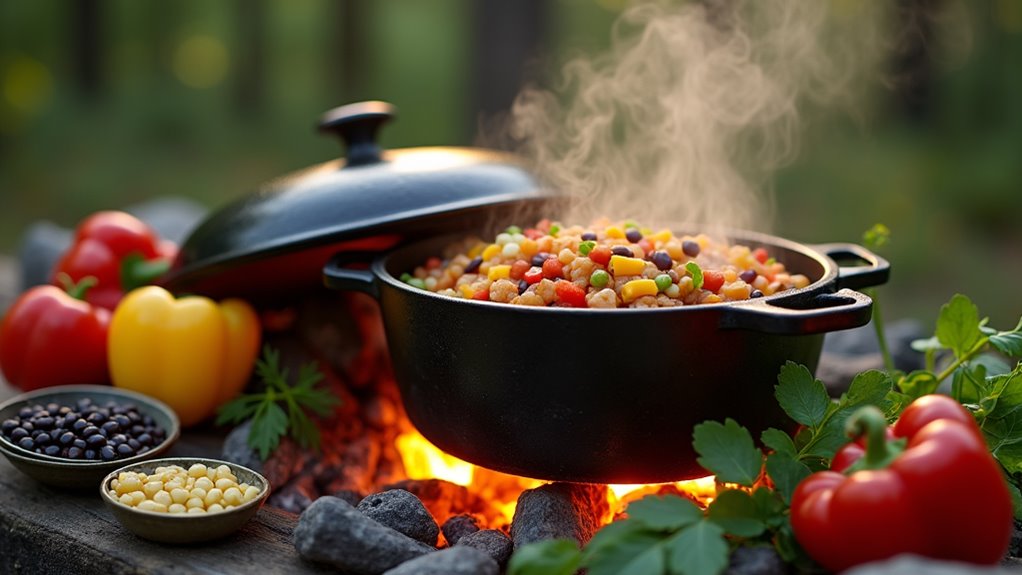
Just discovered how traditional canned meats become nutritious camping fuel with simple ingredient swaps that will revolutionize your outdoor cooking.
You don’t have to throw nutrition out the window when you’re roughing it in the wilderness. Traditional canned meats have earned a bad reputation, but they’re actually camping gold when you know how to work with them. With a few simple upgrades and smart ingredient swaps, you can transform those humble cans of salmon, chicken, and tuna into meals that’ll fuel your adventures without weighing down your backpack or your conscience.
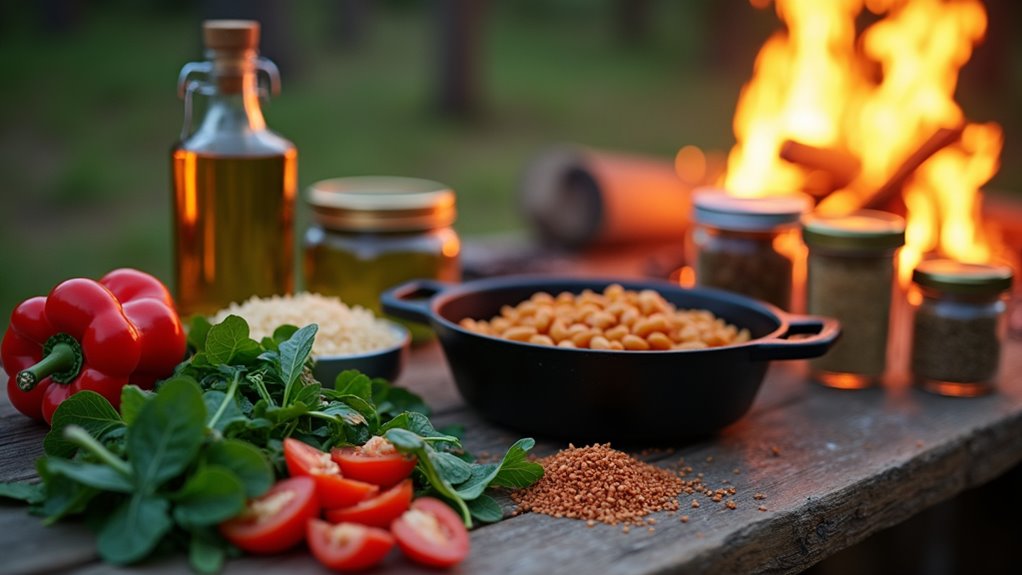
When you’re planning your camping menu, smart ingredient choices make the difference between bland survival food and satisfying meals that actually fuel your outdoor adventures. Stock up on versatile proteins like canned salmon, chicken, and black beans that don’t require refrigeration.
Smart ingredient choices transform your camping meals from bland survival food into satisfying adventures that truly fuel your outdoor experiences.
Pack quinoa and brown rice for complex carbs that cook easily over camp stoves. Don’t forget dried herbs, garlic powder, and hot sauce – they transform basic ingredients into flavorful dishes.
Fresh vegetables like bell peppers, onions, and zucchini travel well and add crunch to one-pot meals. Nuts, seeds, and dried fruits provide healthy fats and natural energy.
Olive oil, coconut oil, and nut butters are calorie-dense essentials that enhance both nutrition and taste in your outdoor cooking adventures.
While bacon and eggs sizzling in a cast iron pan will always have their place at the campsite, you can easily transform these morning classics into more nutritious powerhouses without sacrificing that satisfying campfire taste. Swap regular bacon for turkey bacon or add spinach and bell peppers to create a hearty scramble.
Try whole grain English muffins instead of white bread for your breakfast sandwiches.
Pancakes don’t have to be sugar bombs either. Use whole wheat flour, add mashed bananas for natural sweetness, and toss in some chopped nuts or berries.
Oatmeal becomes camping-worthy when you dress it up with dried fruits, cinnamon, and a drizzle of honey. These simple swaps keep breakfast familiar while boosting nutrition.
After a great night’s sleep on a quality air mattress, you’ll have the energy to prepare these nutritious breakfast options that will fuel your outdoor adventures.
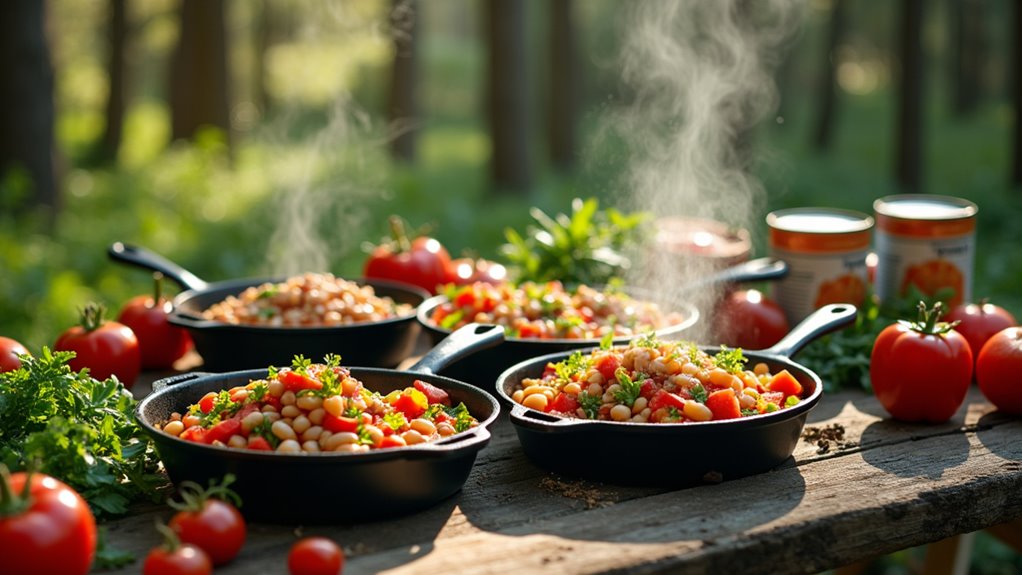
As the sun climbs higher and your morning hike winds down, you’ll want lunch options that refuel your body without weighing you down for afternoon adventures.
Transform traditional canned soup by adding fresh vegetables you’ve packed. Toss diced bell peppers, carrots, or spinach into chicken noodle soup for extra vitamins and crunch. You’ll boost fiber while keeping preparation simple.
Create protein-packed wraps using canned beans or salmon. Mash chickpeas with olive oil and spices, then spread on tortillas with fresh greens. Canned salmon mixed with avocado makes another nutrient-dense filling that’s ready in minutes.
For something warm, try quinoa bowls using instant varieties. Mix in canned black beans, corn, and whatever fresh produce you’ve brought. These combinations deliver complete proteins and sustained energy for your afternoon activities.
Before planning your meals, consider what camping style works best for your group, as this will influence your cooking equipment and food storage options.
After a full day of outdoor activities, you’ll crave satisfying dinners that deliver both comfort and nutrition around the campfire. Transform classic camping meals by sneaking in extra vegetables and lean proteins without sacrificing that rustic flavor you love.
Start with foil packet dinners—they’re foolproof and customizable. Wrap seasoned chicken or fish with colorful bell peppers, zucchini, and sweet potatoes. The steam creates tender, flavorful results every time.
These recipes prove healthy doesn’t mean bland.
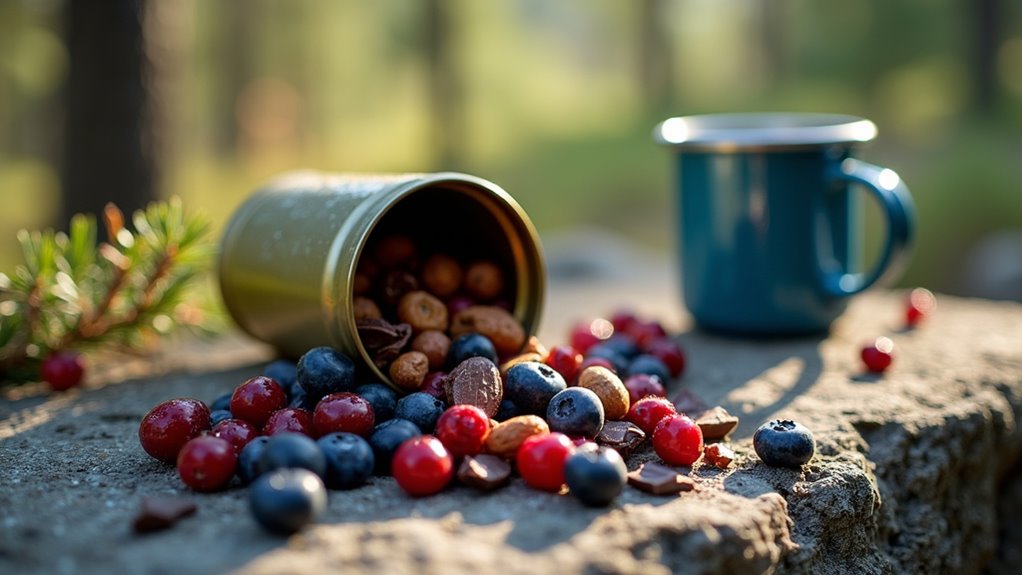
Between those hearty campfire meals, you’ll need energy-boosting snacks that won’t weigh down your backpack or spike your blood sugar. Ditch the processed bars and create your own trail mix combinations using nuts, seeds, and dried fruit without added sugar.
Skip the sugar-laden energy bars and fuel your outdoor adventures with homemade trail mix that delivers lasting energy without the crash.
Try mixing almonds, pumpkin seeds, and unsweetened dried cranberries for sustained energy. Or combine walnuts, dark chocolate chips, and freeze-dried strawberries for a satisfying treat. Add coconut flakes or sunflower seeds for extra crunch.
Pack individual portions in small containers to control serving sizes. Include protein-rich options like beef jerky, hard-boiled eggs, or cheese sticks. Apple slices with nut butter packets work great for quick fuel.
These smart combinations keep you energized without the sugar crash that derails outdoor adventures.
When you’re exhausted from hiking and the last thing you want is a pile of dirty dishes, one-pot meals become your best friend at the campsite. These nutritious powerhouses combine protein, vegetables, and carbs in a single vessel, maximizing flavor while minimizing cleanup time.
Start with a sturdy base like quinoa, rice, or pasta, then layer in canned beans, pre-cut vegetables, and your favorite seasonings. The beauty lies in timing—add harder vegetables first, then softer ones, ensuring everything cooks evenly.
Here are three winning combinations to try:
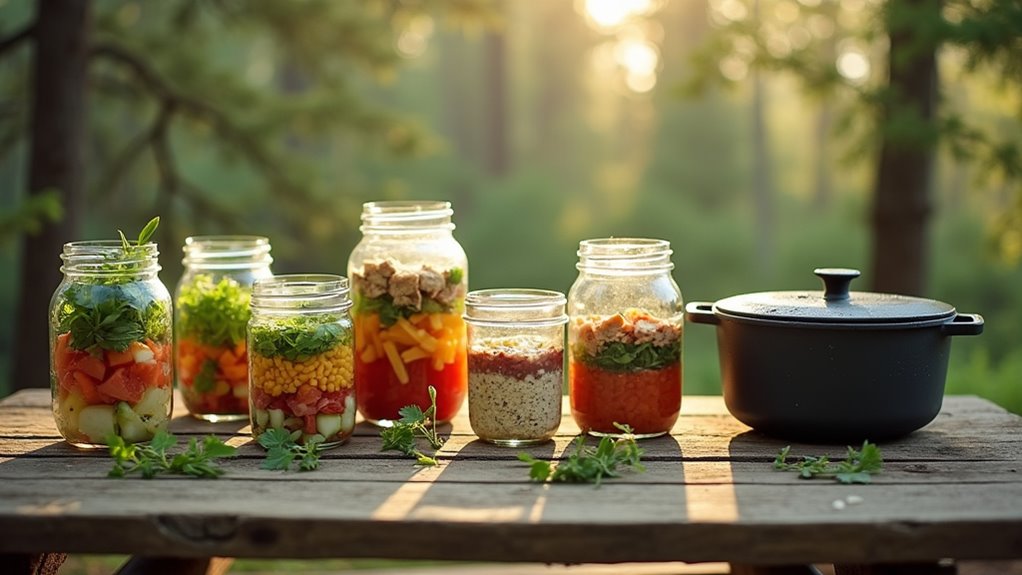
The secret to stress-free camp cooking starts at home, not at the campsite. You’ll save time and eat better by prepping ingredients before you leave. Chop vegetables, portion proteins, and mix dry spice blends at home. Store everything in labeled containers or zip-lock bags.
Pre-cook grains like quinoa and brown rice – they’ll keep for days and reheat quickly over camp stoves. Marinate meats overnight before freezing them; they’ll thaw and flavor simultaneously in your cooler.
Prep grains at home and freeze marinated proteins to save precious time and effort at your campsite.
Create meal kits by combining all ingredients for specific recipes in single containers. Include cooking instructions on waterproof labels. This eliminates guesswork and reduces cleanup.
Don’t forget healthy snacks. Pre-portion nuts, dried fruits, and energy balls into grab-and-go bags for easy trail fuel.
Consider whether a camping sink is worth the space in your gear setup, as proper food prep and cleanup become even more important when you’re preparing fresh, healthy meals at your campsite.
While proper meal prep sets you up for success, keeping fresh ingredients safe in the wilderness requires different strategies than your home kitchen. You’ll need to think beyond basic cooler storage to prevent foodborne illness and spoilage.
Temperature control becomes critical when you’re miles from medical help. Keep your cooler below 40°F by checking with a thermometer and invigorating ice regularly. Pack raw meats in sealed containers at the bottom, away from ready-to-eat foods.
Smart storage protects both your health and your outdoor adventure. Consider staying in touch with your base camp or emergency contacts to share your meal plans and check-in schedule for added safety during extended camping trips.
You’ll never look at canned meat the same way again! These ridiculously simple upgrades transform boring camping staples into absolutely spectacular outdoor feasts that’ll make your taste buds dance around the campfire. You’re not just surviving in the wilderness anymore – you’re thriving with powerhouse nutrition that fuels epic adventures. Pack these game-changing recipes and watch fellow campers beg for your secrets. Your camp kitchen just became the envy of every outdoor enthusiast!